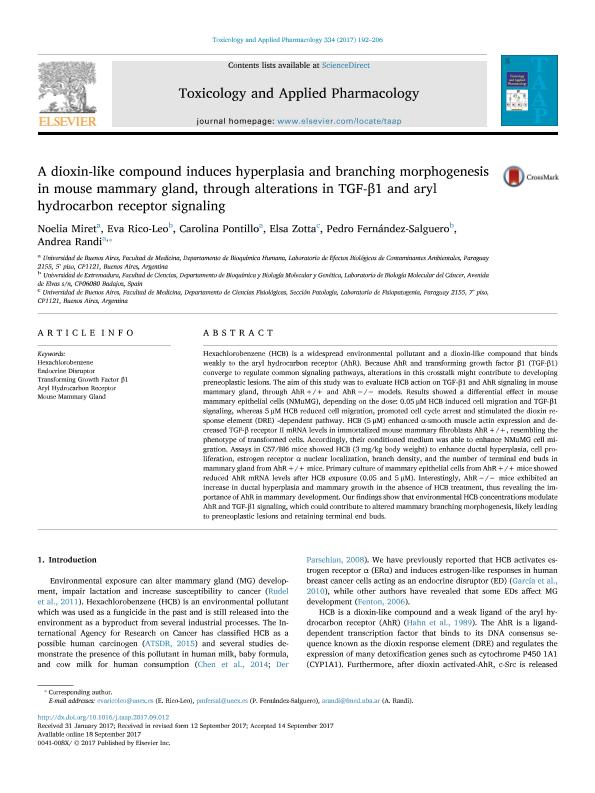Artículo
A dioxin-like compound induces hyperplasia and branching morphogenesis in mouse mammary gland, through alterations in TGF-β1 and aryl hydrocarbon receptor signaling
Miret, Noelia Victoria ; Rico Leo, Eva; Pontillo, Carolina Andrea
; Rico Leo, Eva; Pontillo, Carolina Andrea ; Zotta, Elsa; Fernández Salguero, Pedro; Randi, Andrea Silvana
; Zotta, Elsa; Fernández Salguero, Pedro; Randi, Andrea Silvana
 ; Rico Leo, Eva; Pontillo, Carolina Andrea
; Rico Leo, Eva; Pontillo, Carolina Andrea ; Zotta, Elsa; Fernández Salguero, Pedro; Randi, Andrea Silvana
; Zotta, Elsa; Fernández Salguero, Pedro; Randi, Andrea Silvana
Fecha de publicación:
11/2017
Editorial:
Academic Press Inc Elsevier Science
Revista:
Toxicology and Applied Pharmacology
ISSN:
0041-008X
Idioma:
Inglés
Tipo de recurso:
Artículo publicado
Clasificación temática:
Resumen
Hexachlorobenzene (HCB) is a widespread environmental pollutant and a dioxin-like compound that binds weakly to the aryl hydrocarbon receptor (AhR). Because AhR and transforming growth factor β1 (TGF-β1) converge to regulate common signaling pathways, alterations in this crosstalk might contribute to developing preneoplastic lesions. The aim of this study was to evaluate HCB action on TGF-β1 and AhR signaling in mouse mammary gland, through AhR +/+ and AhR −/− models. Results showed a differential effect in mouse mammary epithelial cells (NMuMG), depending on the dose: 0.05 μM HCB induced cell migration and TGF-β1 signaling, whereas 5 μM HCB reduced cell migration, promoted cell cycle arrest and stimulated the dioxin response element (DRE) -dependent pathway. HCB (5 μM) enhanced α-smooth muscle actin expression and decreased TGF-β receptor II mRNA levels in immortalized mouse mammary fibroblasts AhR +/+, resembling the phenotype of transformed cells. Accordingly, their conditioned medium was able to enhance NMuMG cell migration. Assays in C57/Bl6 mice showed HCB (3 mg/kg body weight) to enhance ductal hyperplasia, cell proliferation, estrogen receptor α nuclear localization, branch density, and the number of terminal end buds in mammary gland from AhR +/+ mice. Primary culture of mammary epithelial cells from AhR +/+ mice showed reduced AhR mRNA levels after HCB exposure (0.05 and 5 μM). Interestingly, AhR −/− mice exhibited an increase in ductal hyperplasia and mammary growth in the absence of HCB treatment, thus revealing the importance of AhR in mammary development. Our findings show that environmental HCB concentrations modulate AhR and TGF-β1 signaling, which could contribute to altered mammary branching morphogenesis, likely leading to preneoplastic lesions and retaining terminal end buds.
Archivos asociados
Licencia
Identificadores
Colecciones
Articulos(OCA HOUSSAY)
Articulos de OFICINA DE COORDINACION ADMINISTRATIVA HOUSSAY
Articulos de OFICINA DE COORDINACION ADMINISTRATIVA HOUSSAY
Citación
Miret, Noelia Victoria; Rico Leo, Eva; Pontillo, Carolina Andrea; Zotta, Elsa; Fernández Salguero, Pedro; et al.; A dioxin-like compound induces hyperplasia and branching morphogenesis in mouse mammary gland, through alterations in TGF-β1 and aryl hydrocarbon receptor signaling; Academic Press Inc Elsevier Science; Toxicology and Applied Pharmacology; 334; 11-2017; 192-206
Compartir
Altmétricas



